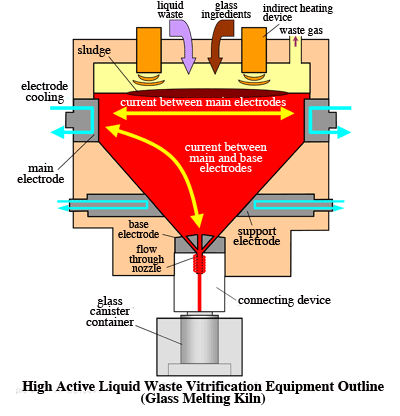Japan Nuclear Fuel Ltd. (JNFL) is supposed to be conducting active tests at the Rokkasho Reprocessing Plant, but in reality the plant has been effectively out of action for around nine months since the end of 2007. The reason is that problems continue to plague the vitrification facility, which mixes high active liquid waste with molten glass, in order to seal the radioactive waste in glass canisters. As a result, in July JNFL was forced to announce that the date for completion of active tests had been postponed until November. However, even in the unlikely event that the facility operates without a hitch from now on, this is already an impossible schedule. There is no chance that the plant will commence commercial operations before 2009.

During tests carried out over a period of about a month at the end of 2007, JNFL was unable to maintain the glass melting kiln at the required constant temperature of 1,200oC. As a result, platinum group elements (palladium, ruthenium, etc.) contained in the high active liquid waste accumulated at the bottom of the kiln, blocking the outlet and preventing the waste from flowing smoothly into the canisters below. The tests were held up for the next six months while JNFL tried to fix the problem. On July 2 the tests were finally recommenced, but although the liquid flowed down for a moment, the flow stopped almost immediately. Further attempts to recommence the tests failed and the facility remains as it was, with radioactive waste and glass still stuck in the kiln. This dangerous situation was not even foreseen in the operation manual.
In September, two months after the latest attempt to operate the facility, the situation has only just become clear. According to JNFL, molten glass became stuck around the flow-through nozzle at the bottom of the kiln. JNFL used a heater made especially to deal with this problem to remelt the glass that had become stuck to the nozzle to allow it to flow through. An implement was then used to remove the remaining glass that had adhered to the high frequency heating coil. In addition, the coupling device which connects the nozzle to the canisters into which the glass flows was removed for inspection. The cause and mechanism by which the molten glass became stuck is still unclear. Consequently, there is no indication when the tests will recommence.
All sorts of problems have arisen in the production of high-level waste glass canisters at the Rokkasho Reprocessing Plant. It is still not possible to determine the causes of the problems, or appropriate responses to these problems. Stable production of glass canisters is one of the acceptance conditions for the active tests. Obviously, it is impossible to give approval for commercial operation of the plant if it does not have the capability to produce glass canisters.
Masako Sawai (CNIC)

